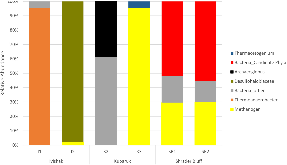Genome-Resolved Metagenomic Analysis Reveals Roles for Candidate Phyla and Other Microbial Community Members in Biogeochemical Transformations in Oil Reservoirs
- Lawrence Berkeley National Lab. (LBNL), Berkeley, CA (United States). Dept. of Ecology, Climate and Ecosystem Sciences Division
- Univ. of California, Berkeley, CA (United States). Dept. of Earth and Planetary Sciences
- Univ. of Texas, Austin, Port Aransas, TX (United States). Dept. of Marine Science, Marine Science Institute
ABSTRACT Oil reservoirs are major sites of methane production and carbon turnover, processes with significant impacts on energy resources and global biogeochemical cycles. We applied a cultivation-independent genomic approach to define microbial community membership and predict roles for specific organisms in biogeochemical transformations in Alaska North Slope oil fields. Produced water samples were collected from six locations between 1,128 m (24 to 27°C) and 2,743 m (80 to 83°C) below the surface. Microbial community complexity decreased with increasing temperature, and the potential to degrade hydrocarbon compounds was most prevalent in the lower-temperature reservoirs. Sulfate availability, rather than sulfate reduction potential, seems to be the limiting factor for sulfide production in some of the reservoirs under investigation. Most microorganisms in the intermediate- and higher-temperature samples were related to previously studied methanogenic and nonmethanogenic archaea and thermophilic bacteria, but one candidate phylum bacterium, a member of theAcetothermia(OP1), was present in Kuparuk sample K3. The greatest numbers of candidate phyla were recovered from the mesothermic reservoir samples SB1 and SB2. We reconstructed a nearly complete genome for an organism from the candidate phylumParcubacteria(OD1) that was abundant in sample SB1. Consistent with prior findings for members of this lineage, the OD1 genome is small, and metabolic predictions support an obligately anaerobic, fermentation-based lifestyle. At moderate abundance in samples SB1 and SB2 were members of bacteria from other candidate phyla, includingMicrogenomates(OP11),Atribacteria(OP9), candidate phyla TA06 and WS6, andMarinimicrobia(SAR406). The results presented here elucidate potential roles of organisms in oil reservoir biological processes. IMPORTANCEThe activities of microorganisms in oil reservoirs impact petroleum resource quality and the global carbon cycle. We show that bacteria belonging to candidate phyla are present in some oil reservoirs and provide the first insights into their potential roles in biogeochemical processes based on several nearly complete genomes.
- Research Organization:
- Lawrence Berkeley National Laboratory (LBNL), Berkeley, CA (United States)
- Sponsoring Organization:
- USDOE
- Grant/Contract Number:
- AC02- 05CH11231; SC0004918; AC02-05CH11231
- OSTI ID:
- 1256078
- Alternate ID(s):
- OSTI ID: 1379039
- Journal Information:
- mBio (Online), Vol. 7, Issue 1; ISSN 2150-7511
- Publisher:
- American Society for MicrobiologyCopyright Statement
- Country of Publication:
- United States
- Language:
- English
Web of Science
Similar Records
Metabolic interdependencies between phylogenetically novel fermenters and respiratory organisms in an unconfined aquifer
Small Genomes and Sparse Metabolisms of Sediment-Associated Bacteria from Four Candidate Phyla






